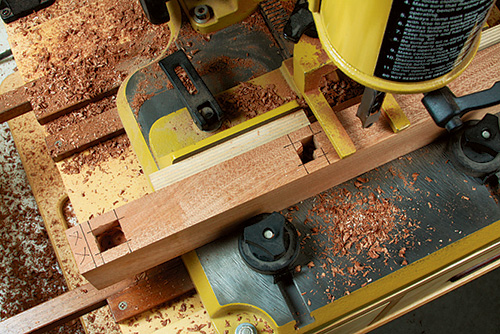
I just purchased a mortising chisel for my drill press. While practicing on pine, I can’t seem to get it to cut easily. A friend has the exact same setup (drill press and mortising adapter) and has no trouble cutting into walnut. When I apply pressure to the press, I end up bowing the table. I have adjusted the drill bit up and down inside the chisel to many different depths. It appears that the wood gets clogged in the chisel and keeps the bit/chisel from going any further into the workpiece until the clog is removed. As suggested by the manufacturer, I have the drill press set at the slowest speed available. I have purchased different chisels. Is the wood too soft? Is the speed on my drill press too slow – about 750 rpm?
Lee Grindinger: Your chisels are too dull for the softness of pine. The softer woods like pine are tough because their softness makes it easy to crush the fibers rather than cut through them. I stress this point when I teach woodcarving. The cutting edge must be sharp enough to cut the wood before the pressure exerted crushes the fibers. Softer woods require extremely sharp chisels to avoid crushing. You may consider an alternative to a mortise chisel for pine such as hand cut mortises or using a router.
If you want to make your mortiser work in pine you need to sharpen the chisel. Comparing the mortise chisel to your bench chisels, you’ll see the bezel is on the inside. It’s imperative that the mortise chisel be sharpened and polished with the plane of the outside surfaces left completely flat and straight to the cutting edge. All of the honing is done on the inside of the chisel while the lapping is done on the outside. The drill bit should be set just inside of the cutting edges.
Rob Johnstone: Drilling square holes is such a great idea…but it comes with some challenges. While I can’t say from here what the exact problem might be, but there are some simple steps to improving mortising attachment performance. First, all the cutting edges of the chisel and the auger need to be very sharp. Even a new tool right from the box should be honed to an extremely sharp edge. Second, the chip ports on the chisel may have burrs on their edges, which impede the waste from exiting the chisel housing. Try filing the edges of the ports to make sure they are smooth. Also, it occurs to me that a slow bit speed may be more appropriate for hardwoods and a faster speed for softwoods. The combination of a slower bit speed, and the more aggressive “bite” that a softer wood tissue will allow the bit, may be creating chips that are simply too large to push out of the chisel’s waste port. If you speed up the bit and cut a little slower into the softwood, you may get better results.
My best advice is just to keep on trying different techniques until you find one that works.
Simon Watts: Pine is harder to cut cleanly than walnut because the fibers tend to compress. Try a higher speed and make sure the chisel is as keen as you can make it — hone each side flat on a medium water stone.






